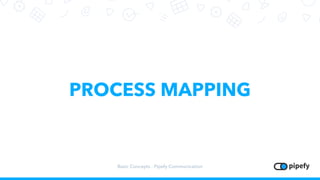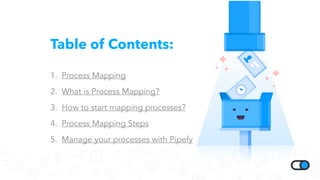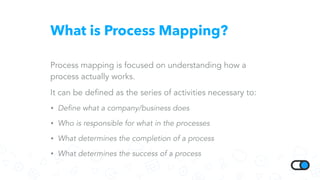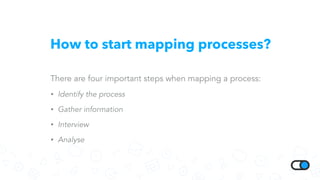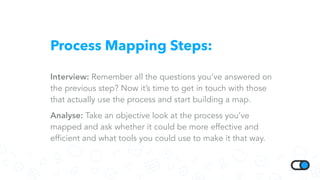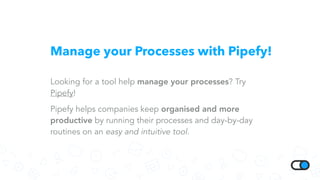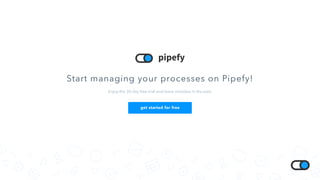What is process mapping?
- 1. PROCESS MAPPING Basic Concepts - Pipefy Communication
- 2. Powered by
- 3. Table of Contents: 1. Process Mapping 2. What is Process Mapping? 3. How to start mapping processes? 4. Process Mapping Steps 5. Manage your processes with Pipefy
- 4. Process Mapping: If youâve ever planned ahead on your activities by clearly stating the steps and actions you had to take - not necessarily on a flowchart - congratulations! Youâve mapped a process (even if you didnât realise it at the time). To better understand why you should map your processes - and how you can do it - letâs first deïŽne process mapping.
- 5. What is Process Mapping? Process mapping is focused on understanding how a process actually works. It can be defined as the series of activities necessary to: âĒ Define what a company/business does âĒ Who is responsible for what in the processes âĒ What determines the completion of a process âĒ What determines the success of a process
- 6. What is Process Mapping? What you get from mapping your processes? Well, most businesses decide to go for process mapping because itâs an important tool to improve efïŽciency. Having a clear and defined process allows you to look at your processes âfrom the outsideâ. It also helps whenever you hire consultants to evaluate your processes and help you decide on making improvements on what you currently have.
- 7. What is Process Mapping? Business process mapping also allows you to pick a specific objective and measure, track and compare this specific point alongside your businessâ overall objective. By doing so, youâre able to determine whether a specific process is aligned with the companyâs general goals and capabilities.
- 8. How to start mapping processes? There are four important steps when mapping a process: âĒ Identify the process âĒ Gather information âĒ Interview âĒ Analyse
- 9. Process Mapping Steps: Identify the process: Of course the first step when mapping a process is taking an objective look at it and trying to fully understand all its steps. Gather information: After realising what a process does and how it does it, letâs take a look at why it does it (objectives), what can go wrong with it (risks) and how you can measure it (key controls).
- 10. Process Mapping Steps: Interview: Remember all the questions youâve answered on the previous step? Now itâs time to get in touch with those that actually use the process and start building a map. Analyse: Take an objective look at the process youâve mapped and ask whether it could be more effective and efficient and what tools you could use to make it that way.
- 11. Manage your Processes with Pipefy! Looking for a tool help manage your processes? Try Pipefy! Pipefy helps companies keep organised and more productive by running their processes and day-by-day routines on an easy and intuitive tool.
- 12. Start managing your processes on Pipefy! Enjoy the 30-day free trial and leave mistakes in the past. get started for free

